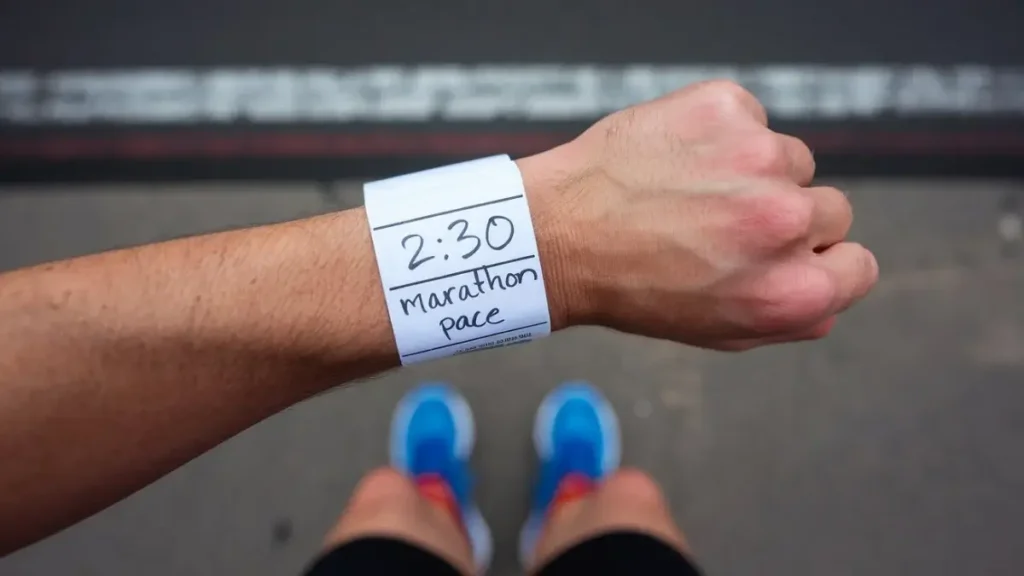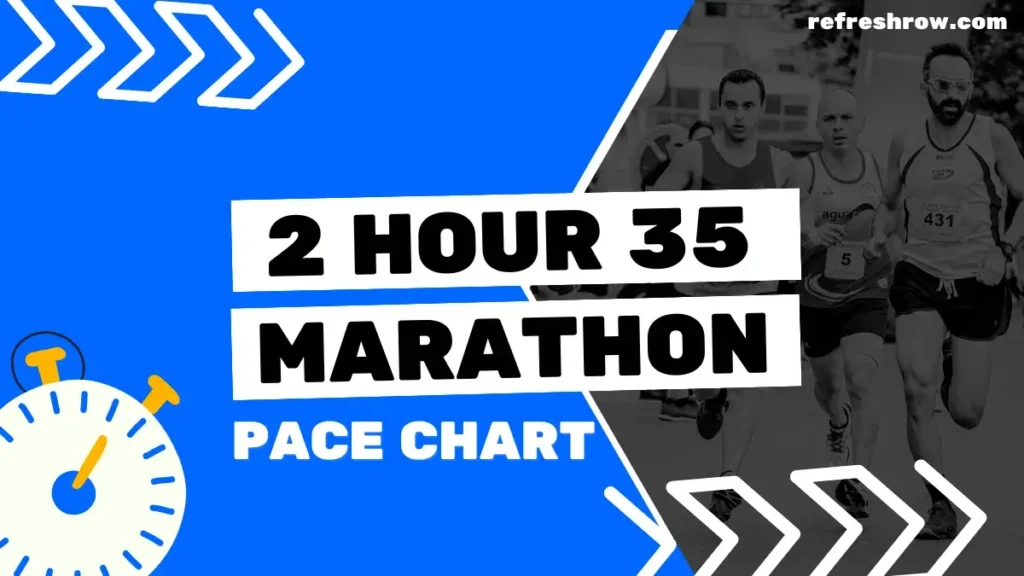To run a 3:25 hour marathon you need to run at a pace of 7:49 per mile or 4:52 per kilometer.
Following the splits below (and shaving off a second), you’ll run a sub 3:25 marathon.
I’d recommend aiming to run 1-2 minutes ahead of the split target time from 10 miles, as you’ll likely come up against crowding on race day.
3:25 Marathon Pace in Miles
| Mile | Split |
|---|---|
| 1 | 7:49 |
| 2 | 15:38 |
| 3 | 23:27 |
| 4 | 31:17 |
| 5 | 39:06 |
| 6 | 46:55 |
| 7 | 54:44 |
| 8 | 1:02:33 |
| 9 | 1:10:22 |
| 10 | 1:18:11 |
| 11 | 1:26:00 |
| 12 | 1:33:50 |
| 13 | 1:41:39 |
| 14 | 1:49:28 |
| 15 | 1:57:17 |
| 16 | 2:05:06 |
| 17 | 2:12:55 |
| 18 | 2:20:44 |
| 19 | 2:28:33 |
| 20 | 2:36:23 |
| 21 | 2:44:12 |
| 22 | 2:52:01 |
| 23 | 2:59:50 |
| 24 | 3:07:39 |
| 25 | 3:15:28 |
| 26 | 3:23:17 |
| 26.2 | 3:25:00 |
3:25 Marathon Pace in KM
| KM | Split |
|---|---|
| 1 | 4:52 |
| 2 | 9:43 |
| 3 | 14:35 |
| 4 | 19:26 |
| 5 | 24:18 |
| 6 | 29:09 |
| 7 | 34:01 |
| 8 | 38:52 |
| 9 | 43:44 |
| 10 | 48:35 |
| 11 | 53:27 |
| 12 | 58:18 |
| 13 | 1:03:10 |
| 14 | 1:08:01 |
| 15 | 1:12:53 |
| 16 | 1:17:44 |
| 17 | 1:22:36 |
| 18 | 1:27:27 |
| 19 | 1:32:19 |
| 20 | 1:37:10 |
| 21 | 1:42:02 |
| 22 | 1:46:53 |
| 23 | 1:51:45 |
| 24 | 1:56:36 |
| 25 | 2:01:28 |
| 26 | 2:06:19 |
| 27 | 2:11:11 |
| 28 | 2:16:02 |
| 29 | 2:20:54 |
| 30 | 2:25:45 |
| 31 | 2:30:37 |
| 32 | 2:35:28 |
| 33 | 2:40:20 |
| 34 | 2:45:11 |
| 35 | 2:50:03 |
| 36 | 2:54:54 |
| 37 | 2:59:46 |
| 38 | 3:04:37 |
| 39 | 3:09:29 |
| 40 | 3:14:20 |
| 41 | 3:19:12 |
| 42 | 3:24:03 |
| 42.2 | 3:25:00 |
Other Marathon Pace Charts
Targeting a different time?
Check out the Full Marathon Pace Chart in Miles or KM
Or select a specific finishing time below:
| 3:00 | 4:00 | 5:00 | |
| 3:05 | 4:05 | 5:15 | |
| 3:10 | 4:10 | 5:30 | |
| 3:15 | 4:15 | 5:45 | |
| 3:20 | 4:20 | 6:00 | |
| 3:25 | 4:25 | 6:15 | |
| 2:30 | 3:30 | 4:30 | 6:30 |
| 2:35 | 3:35 | 4:35 | 6:45 |
| 2:40 | 3:40 | 4:40 | 7:00 |
| 2:45 | 3:45 | 4:45 | |
| 2:50 | 3:50 | 4:50 | |
| 2:55 | 3:55 | 4:55 |
Training for a 3:25 Marathon
Is 3:25 a Good Marathon Time?
Well, what do the stats say?
Run Repeat conducted a study that contains 19,614,975 marathon results from more than 32,335 races across the globe, here is how a 3:25 marathon compares against age and gender for the races recorded:
| Overall | You’re faster than 92.7% of all runners. |
| Male | You’re faster than 88.9% of males. |
| Female | You’re faster than 97.7% of females. |
| <20 | You’re faster than 89.1% of under 20s. |
| 20-29 | You’re faster than 89.3% of 20-29 year olds. |
| 30-39 | You’re faster than 90.2% of 30-39 year olds. |
| 40-49 | You’re faster than 93.2% of 40-49 year olds. |
| 50-59 | You’re faster than 97.1% of 50-59 year olds. |
| >60 | You’re faster than 99.3% of over 60s. |
Training Runs and Paces for a 3:25 Marathon
To break a 3:25 marathon you’ll need to do some serious distance in your training, I recommend at least 35 miles (56km) per week.
You’re also going to need to make sure you’ve crossed off these milestones for other race distances:
- A 5k in 21:20 mins
- A 10k in 44:30 mins
- A half marathon in 1 hour 33 mins
Training Paces
| Pace | Mins per Mile | Mins per KM |
|---|---|---|
| Easy | 8:48 | 5:28 |
| Steady | 7:49 | 4:51 |
| 10k | 7:10 | 4:27 |
| 5k | 6:52 | 4:16 |
| 1 Mile | 6:23 | 3:59 |
Weekly Mileage Targets
| Target Mileage: | Gradually increase your weekly mileage from 40 miles (64 km) to a peak of 68 miles (109 km). |
| Incremental Increase: | Increase mileage by approximately 10% each week, with every fourth week as a recovery week where mileage is reduced by 20-30%. Make sure to taper for the last 1-2 weeks. |
Long Run Structure
| Total Distance: | Build up to long runs of 20-22 miles (32-35 km). |
| Segment Example: | First 5 miles (8 km): Easy pace, heart rate 140-150 bpm (approximately 9:00/mile or 5:36/km). Next 1 mile (1.6 km): Fast pace at 6:40/mile (4:09/km). Next 5 miles (8 km): Medium effort, heart rate around 160 bpm (approximately 7:40/mile or 4:46/km). Repeat: Repeat the segment twice (5 miles easy, 1 mile fast, 5 miles medium), you can taper the final 2 miles if required. |
Why This Works: Incorporating varied paces within long runs enhances lactate tolerance, which helps on race day when you’ve got to maintain pace despite feeling fatigued. By practicing surges during a run, you can build up your physical and mental resilience (lots of elite marathon runners use these strategies during their training)
Alternating Long Runs: Alternate between structured long runs (easy/fast segments) and easier long runs. For easier long runs, maintain a steady, comfortable pace throughout, focusing on mileage rather than speed to aid recovery.
Speedwork Sessions
| Short Intervals: | – 800m repeats at 3:20 per interval (4:10/km). – Aim for 6-12 repetitions with equal time for recovery. |
| Mile Repeats: | – 1 mile repeats at 6:40 per mile (4:09/km). – Aim for 6-12 repetitions with a 1-2 minute recovery jog. |
| Longer Intervals: | – 2 mile repeats at 6:50 per mile (4:15/km). – Aim for 5-8 repetitions with a 2-3 minute recovery jog. |
Recovery and Rest Days
| Rest Days: | You don’t need to incorporate rest days if you are using recovery runs, but I recommend taking 1 (or a max of 2) per week to allow your body to recover and prevent overtraining. |
| Easy Run Days: | Include 1-2 easy run days per week at a relaxed pace of 9:15/mile (5:45/km), covering 5-10 miles (8-16 km) per day. Try to keep your heart rate below 140 bpm on easy days to ensure proper recovery and aerobic development. |
My Tips to Run a Sub 3:25 Marathon
Mix Up Your Workouts with Fartlek Runs
Adding variety to my training through fartlek runs was incredibly beneficial.
Fartlek, which means “speed play” in Swedish, involves varying your pace throughout the run, alternating between fast bursts and easy recovery segments.
I incorporated fartlek sessions once a week, often using landmarks or time intervals to structure my bursts of speed.
This not only made my training more fun but also improved my speed and endurance without the mental pressure of structured intervals.
The unpredictability of fartlek runs kept my mind engaged and helped me become more adaptable to changing race conditions.
Build a Supportive Running Community
I joined a local running club and started participating in group runs, which made a huge difference in my journey to a 3:25 marathon.
The camaraderie and encouragement from fellow runners kept me motivated and accountable.
We shared training tips, cheered each other on during tough workouts, and celebrated our progress together.
On days when I felt like skipping a run, knowing that my friends were out there training too gave me the push I needed to lace up my shoes.
The sense of belonging and support from my running community was invaluable and made the training process much more enjoyable.
Dial in Your Nutrition Strategy
Dialing in my nutrition was a game-changer for my marathon training.
I experimented with different types of fuel during my long runs to see what worked best for my body.
I discovered that taking sips of water every 20 minutes and consuming energy gels every 30 minutes with a sports drink chaser kept my energy levels stable without causing stomach issues.
I also paid close attention to my diet overall, ensuring I got a good mix of carbohydrates, proteins, and fats to support my training.
On race day, I carb loaded as normal to boost up my glycogen stores which helped me avoid the dreaded “wall” at mile 20.
Develop a Pacing Strategy That Works for You
One of the most important aspects of my training for a 3:25 marathon was developing a pacing strategy that felt right for me.
During my long runs, I experimented with different paces to find a rhythm that I could maintain comfortably over long distances.
I discovered that starting slightly slower than my target race pace helped conserve energy for the latter stages of the run.
Runners call this “negative splits”. This approach paid off, making sure the last section wasn’t too gruelling.


Row Brown is the founder of Refresh Row. He is a keen marathon runner, his favorite being the London Marathon. He’s now set himself the mission of Running the Entire Length of Spain, which is scheduled for late 2024.


